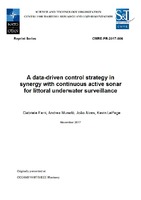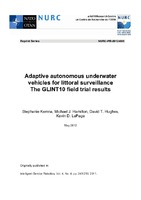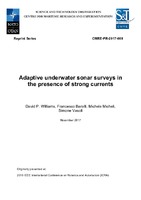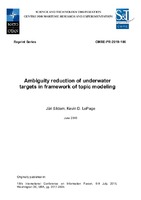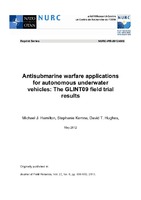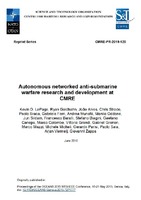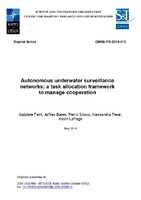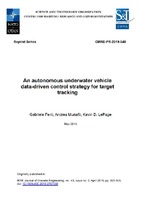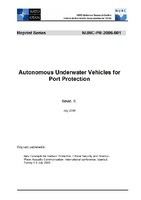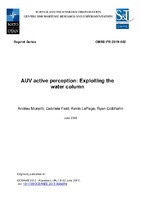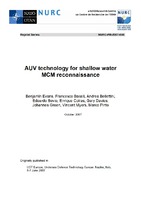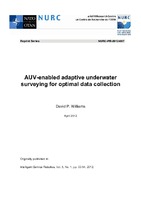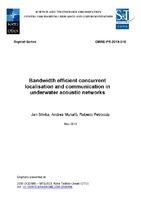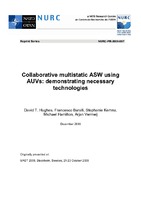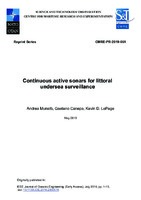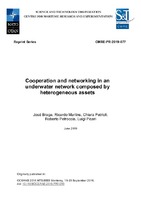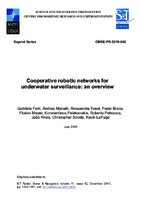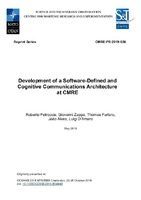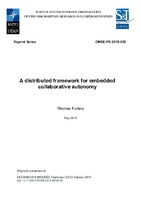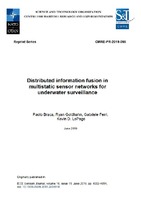Browsing Reprints by Subject "Autonomous Underwater Vehicles (AUV)"
Now showing items 1-20 of 41
-
A data-driven control strategy in synergy with continuous active sonar for littoral underwater surveillance
(CMRE, 2017/11)In this work, we describe a data-driven Mission Management Layer (MML) running on-board AUVs which manages the phases of a littoral surveillance mission and exploits the characteristics of Continuous Active Sonar (CAS) ... -
Adaptive autonomous underwater vehicles for littoral surveillance: the GLINT10 field trial results
(NURC, 2012/05)Autonomous underwater vehicles (AUVs) have gained more interest in recent years for military as well as civilian applications. One potential application of AUVs is for the purpose of undersea surveillance. As research into ... -
Adaptive underwater sonar surveys in the presence of strong currents
(CMRE, 2017/11)We consider the task of conducting underwater surveys with a sonar-equipped autonomous underwater vehicle (AUV) in environments with strong currents. More specifically, this topic is addressed in the context of mine ... -
Ambiguity reduction of underwater targets in framework of topic modeling
(CMRE, 2019/06)An unsupervised track classification approach based on appropriate discriminative and aggregative features derived from beamformed and normalized matched-filtered data is applied to sonar multistatic tracking and extended ... -
Antisubmarine warfare applications for autonomous underwater vehicles: the GLINT09 field trial results
(NURC, 2012/05)Surveillance in antisubmarine warfare (ASW) has traditionally been carried out by means of submarines or frigates with towed arrays. These techniques are manpower intensive. Alternative approaches have recently been suggested ... -
Autonomous networked anti-submarine warfare research and development at CMRE
(CMRE, 2019/06)CMRE has been evaluating the potential of autonomous networked ASW using underwater vehicles through a program of sonar signal processing, underwater communications, navigation and robotic behavior developments and at-sea ... -
Autonomous underwater surveillance networks: a task allocation framework to manage cooperation
(2019/05)The design of efficient task allocation schemes is essential to manage autonomous underwater robotic surveillance networks. The network has to assign the most suited robots to the tasks which compose the mission, in spite ... -
An autonomous underwater vehicle data-driven control strategy for target tracking
(CMRE, 2019/05)This paper presents a data-driven approach to control the movement of autonomous underwater vehicles (AUVs) operating as receivers of a multistatic sonar surveillance network. The algorithm adopts a nonmyopic receding ... -
Autonomous underwater vehicles for port protection
(NURC, 2006/07)NATO's present capability to deal with a terrorist threat to our ports is slow, dangerous, and inefficient. Ports are a challenging area within which to conduct MCM operations due to several factors: shipping movements, ... -
AUV active perception: exploiting the water column
(CMRE, 2019/06)Autonomous Underwater Vehicles (AUVs) present a low-cost alternative or supplement to existing underwater surveillance networks. The NATO STO Centre for Maritime Research and Experimentation is developing collaborative ... -
AUV technology for shallow water MCM reconnaissance
(NURC, 2007/10)The ability to perform MCM reconnaissance missions in shallow water is important in both expeditionary MCM and in the protection of ports against maritime improvised explosive devices (MIEDs). For many years AUV systems ... -
AUV-enabled adaptive underwater surveying for optimal data collection
(NURC, 2012/04)A new adaptive strategy for performing data collection with a sonar-equipped autonomous underwater vehicle (AUV) is proposed. The approach is general in the sense that it is applicable to a wide range of underwater tasks ... -
Bandwidth efficient concurrent localisation and communication in underwater acoustic networks
(CMRE, 2019/05)Localisation is essential for an Autonomous Underwater Vehicle (AUV) to perform its mission and to georeference any data acquired during the dive. When the AUV is part of a heterogeneous underwater acoustic network (UAN), ... -
Collaborative multistatic ASW using AUVs: demonstrating necessary technologies
(NURC, 2009/12)Many research laboratories and several nations are showing an interest in the 'underwater networked battlespace' in which a combination of stationary and mobile underwater platforms communicate wholly or partially by the ... -
Continuous active sonars for littoral undersea surveillance
(CMRE, 2019/05)Recent advances in transducer and computing technology have pushed the concept of continuous active sonar (CAS) or high duty cycle sonar as an area of interest for application to antisubmarine warfare. Unlike conventional ... -
Cooperation and networking in an underwater network composed by heterogeneous assets
(CMRE, 2019/06)Underwater communication and robot technologies have grown rapidly in the last decade. Systems made of underwater unmanned vehicles have moved from single vehicle deployments to systems comprising teams of assets. As of ... -
Cooperative robotic networks for underwater surveillance: an overview
(CMRE, 2019/06)Underwater surveillance has traditionally been carried out by means of surface and undersea manned vessels equipped with advanced sensor systems. This approach is often costly and manpower intensive. Marine robotics is an ... -
Development of a software-defined and cognitive communications architecture at CMRE
(2019/05)This paper presents an overview of the functionalities of the Cognitive Communications Architecture (CCA) that is currently under development at the NATO Science and Technology Organisation (STO) Centre for Maritime Research ... -
A distributed framework for embedded collaborative autonomy
(CMRE, 2019/05)We have designed and implemented a framework for the development and deployment of multi-agent task allocation solutions, with particular awareness of the operational constraints encountered by Unmanned Maritime Systems ... -
Distributed information fusion in multistatic sensor networks for underwater surveillance
(CMRE, 2019/06)Surveillance in antisubmarine warfare has traditionally been carried out by means of submarines or frigates with towed arrays. These techniques are manpower intensive. Alternative approaches have recently been suggested ...
